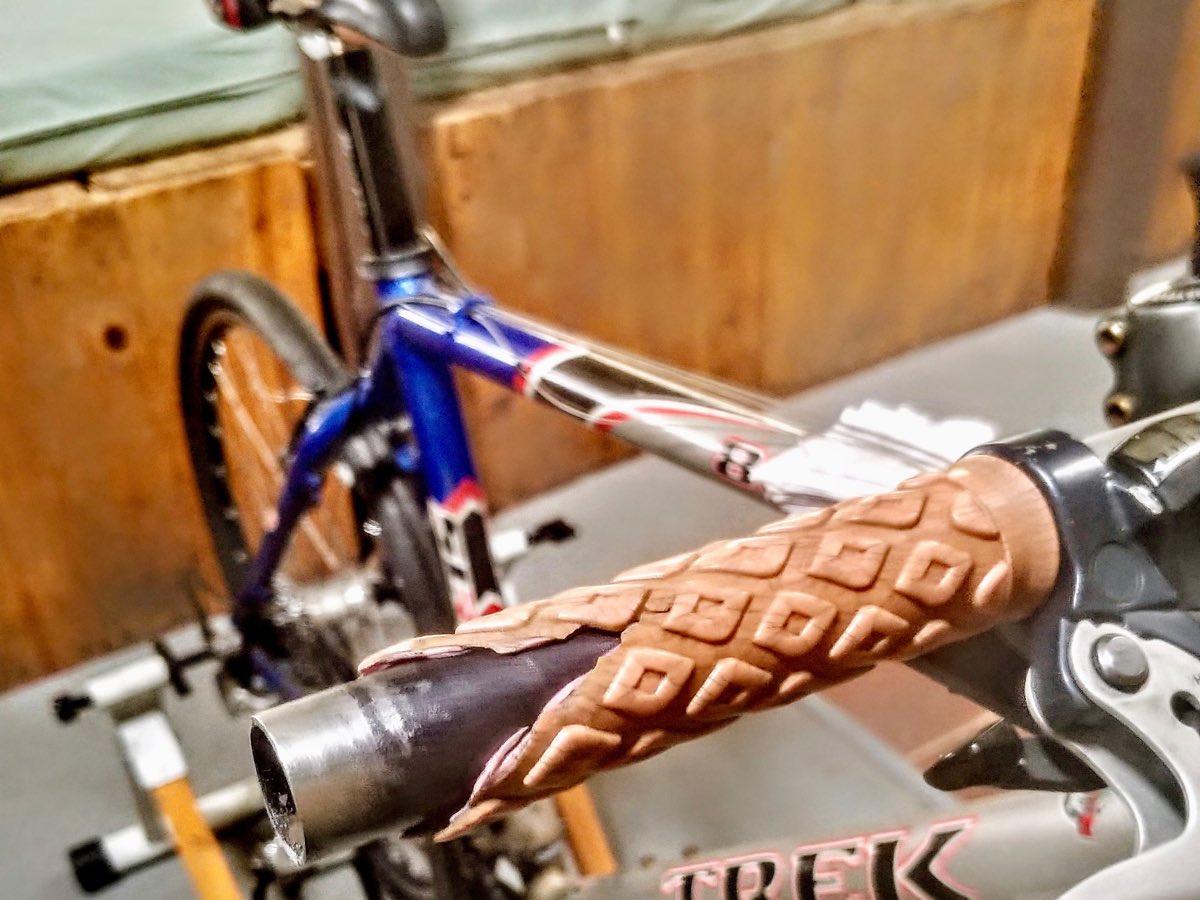I have this old, Trek 8000 mountain bike. I got it the summer between my second and third years of college. I didn’t have to pay a thing for it. Thanks to some prodding from my boss at the time, Nathan Chubet, I spent that summer racing XTERRA triathlons on a heavy, full suspension Iron Horse mountain bike. In the last race of the summer I snapped my frame, so my boss’s buddy gave me his old Trek. He didn’t ask me for any money. “Just make sure it gets used,” is what he said. I carted the bike back to school in Rochester, New York and road it all over campus for the next several years.
When I moved to Colorado in 2014, the bike moved too, but I was so focused on running that it never really got used anymore. Then, a few years ago, I hurt my back on a training run and rode the bike up to where I live at Barr Camp as an alternative mode of travel. But let’s be honest here because it’s generous to say that I rode it. Rode is what I did in a few flatter and downhill sections. Much of it was just a hike with a bike. In fact, I remember lugging the bike up Longs Ranch Road and being surprised when I caught and passed two other bikers. How am I catching people, is what I thought. But they were hiking too. No need to get excited about any sort of biking skills; we were just pushing things up steep grades. I’m supposed to be good at that.
Back to the bike. It’s silver, red, and blue. The front shock no longer gives and the corresponding brake cable hangs loose and disheveled. The pink handle-bar grips were a nice addition about two years ago, as the previous ones had turned into a melted, gooey mess. The goo would have made for some sticky grip, but I prefer that the grip not move to my forehead in the event that I wipe my sweaty brow. Hence, the pink grips made for a nice upgrade. Even these have now seen better days. For some reason the right one is a slippery mess. It won’t stick to the handlebar and so it spins and slides all over the place. It seems odd for a grip to slip, but thinking back I had a heck of a time getting those new grips on. I may have slapped some good ‘ole WD-40 on the bars to help things along. Rookie mistake. Oh well.
Not to worry though, because the slipping isn’t the only flaw here. Somewhere along the way a tear developed in the grip. This has since advanced, leaving the grip about three-quarters of its original length. The wheels are alright but the rear one has a flat and the gearing cassette has worked its way loose. It had done pretty well on the bike trainer, but when I tried to take it out on the trails last fall, the gears started slipping so I returned to camp and parked it back on the trainer. When I hooked it back up to the trainer I made some adjustments to the rear derailleur, but the cables were all frayed and worn at the end. I messed with it a bit, but never got all of the gears to work. I got maybe the second- or third-highest gear cranking and called it good enough.
I rode the bike like that last fall when I was trying to heal some injuries. As the injuries improved, the bike went away, but reappeared this year as I’ve been working my way through some peroneal tendinosis and plantar fasciitis. One day I hopped on the bike and felt especially good. Man, that seemed easier today, I thought. Then I examined the back tire. It was flat. On the trails that would make things harder, but here on the trainer it means a drastic decrease in resistance. So much for the confidence booster, I had been cheating the whole time.
I searched for the bike pump but couldn’t find it. With the stores 6.5 trail miles away, I just kept cranking away on that deflated tire. Then, one day I dug out the slick that my friend Paul Smith had brought me. Unfortunately it too was flat. I put it on anyhow to decrease the noise pollution caused by that knobby mountain-bike tire. I didn’t want camp guests to hear all that racket. The only trouble was that the slick tire provided even less resistance than the mountain-bike tire. This was an easy-enough fix. I pulled out an Allen wrench and tightened up the rear brake. Conventional? No. Effective? You bet.
About a month later and we have acquired a new bike pump. It worked like a charm on the front wheel, but the rear wheels seem to have holes in them (go figure), so we’re still rocking that same old limp-noodle set-up until we patch them or swap in different tubes.
I say all of this because I’m a proponent of working with what you’ve got. In a day and age when society is obsessed with gadgets and gizmos, I like to keep it simple. I like function more than flair and making the most of what I already have. Sure, there is a place for upgrades and improvements. Every now and then, you ought to buy a new frying pan or your breakfast will either always stick or forever be caked in butter. But don’t knock something just because it’s a little old or not quite ideal. A few months ago we found an old waffle iron tucked away in storage here at Barr Camp. Excited, we cleaned it up, threw it on the wood stove, cranked the fire, and made some killer waffles. Just because something is old doesn’t mean it’s useless.
The same is true with running. You are bound to face a few scenarios that aren’t ideal. It could be an untimely injury during training, a mid-race low, an insanely busy schedule, a major mental stressor, or something else. Bumps happen. Keep going.
Thinking of this, I’m reminded of the way in which author Michael Perry describes his bother-in-law in his book Truck: A Love Story. “And yet, compared to Mark,” Perry writes, “I am Richard Simmons. Mark is an eighth-level Zen master of stoicism. His philosophy can be distilled to three words: ‘Walk it off.’ He uses it in every context. Hit your head on the hood? ‘Walk it off.’ Burn your hand on the exhaust? ‘Walk it off.’ Wife left you for the Schwan’s man? ‘Walk it off.’”
For some, this walk-it-off mentality may sound delusional, like a call to just brush things aside and pretend they never happened. But the term ‘walk it off’ can be traced back to sports. When an athlete gets hurt, walk it off doesn’t mean to pretend the injury never happened. Walk it off means to slow down, but to also keep moving as you work your way through it.
I think this walk-it-off mentality is very important for dealing with the ups and downs of training–and life. Life doesn’t always give us the best bike on the market. Sometimes we have to ride a beat-up jalopy with gears that slip, pedals that creak, and tires that won’t hold air. The bike doesn’t have to be perfect, but what is important is that we keep moving. We have to work with what we’ve got as we walk it off.
I think this is another way of saying that we have to have hope. A lack of hope sits down on the sidelines. It wallows and frets and gives up. But hope keeps us going. It urges us to find a way, pinpoint the things we do have, and employ them in ways that help us get what we want. A little while ago, I read something intriguing. It was a lesson learned by Lazarus Lake, the director of the infamous Barkley Marathons and Big Backyard Ultra. To paraphrase, what Lake learned is that people don’t quit when they can’t go any farther, they quit when they’ve lost hope that they can succeed.
It’s a fascinating thought: the importance of hope. Hope doesn’t guarantee success. It doesn’t make the injury any less or fix a busted derailleur. And yet, it provides a very important fuel for the fire. It urges us onward. It keeps us going. It enables us to work with what we’ve got. Some say hope floats; I say it walks (it off).
Call for Comments (from Meghan)
- What’s an example from life where you’ve successfully ‘walked it off?’
- And, what’s another example where you could do a little better with making do with what you have even if it isn’t the best?


